Having the best astrophotography apps on your smartphone or tablet can be a fantastic and inexpensive shortcut toward nailing a great shot of the night sky.
The difference between taking a great astronomy photograph or not can often be external factors, such as finding the right location, waiting for optimal conditions, and timing it right.
There are some great free (or cheap) apps available that can help your astrophotography by helping:
- Finding the right locations
- Checking the weather conditions, and
- Enabling you to plan and compose shots
Below, we profile the best astrophotography apps that are used and recommended by experts.
1. Best astrophotography planning apps
Photopills – best all-round night photography app
Photopills is a great app for Milky Way and night sky photography, and one of the best all-round photography planning apps available
It has a wide range of functions, but its planner is where it really shines. It allows you to scout out any location on the planet at any date in the future and get all the vital information you need, including the timings of:
- Sunset and sunrise
- The phase of the moon
- Blue hour and golden hour
- Visibility of the Milky Way’s galactic core and where it will be in the sky
In this screenshot below, you can see that in a location near Boulder, Colorado on 8 June 2021, the Milky Way core will be visible from 22:29 to 03:31 and will be in the southern sky (moving west as the night progresses).
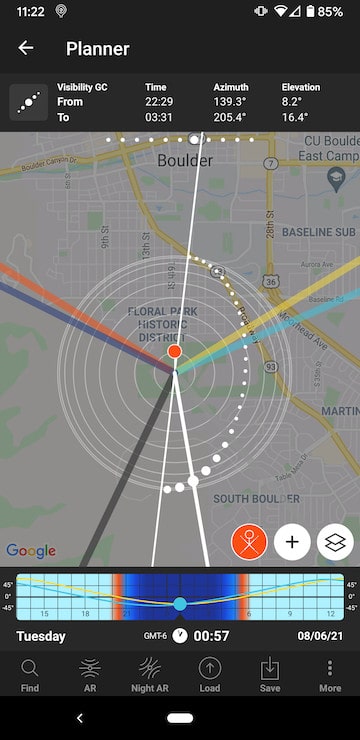
It also enables you to visualize shots using its night augmented reality function.
Astrophotographer Talman Madsen outlines how he uses Photopills for Milky Way photography in this piece. He says
“I used the app to plan for a night where the moon was absent to maximize the contrast in the sky, therefore, making the stars ‘pop’.”
It’s also described as a great tool to plan ahead by Laura Krause.
Photopills costs $9.99 at the time of writing.
Stellarium – best quick planning reference
Stellarium is my favorite quick and easy way to work out what’s going to be in the night sky tonight and in the near future.
For example, this screenshot shows that from my location around 01:50 tonight, part of the Milky Way core and the planet and Saturn will be visible in the southern skies:
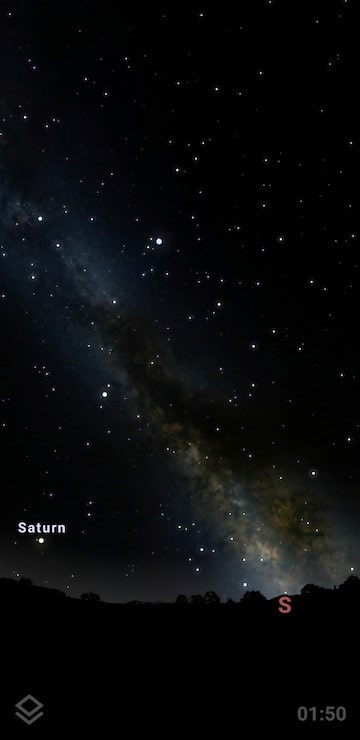
Photographer Ivan Slade outlines how he used Stellarium to help him capture the Milky Way in this piece. He says,
“For the actual Milky Way orientation and times I use Stellarium, which allows you to lock in a location, date and time to view the location of the Milky Way and other sky objects.”
It has useful functionality such as being able to turn on and off the atmosphere (light pollution) for where you are, the landscape, grids and lines, and the constellations of the stars.
Importantly for using in the dark at night when shooting the stars, it has a night mode function so it won’t ruin the adjustment of your eyes to the dark.
Stellarium is free and available for use through the website on desktop and also with a free mobile app that has additional paid upgrade functions (including being able to control your computerized telescope).
Photographer’s Ephemeris – best Milky Way finder app
One of the best astronomy apps, The Photographer’s Ephemeris (TPE), is a website and app that, like Stellarium, can be used for calculating the positioning and timing of the sunrise and sunset, as well as the moon and Milky Way.
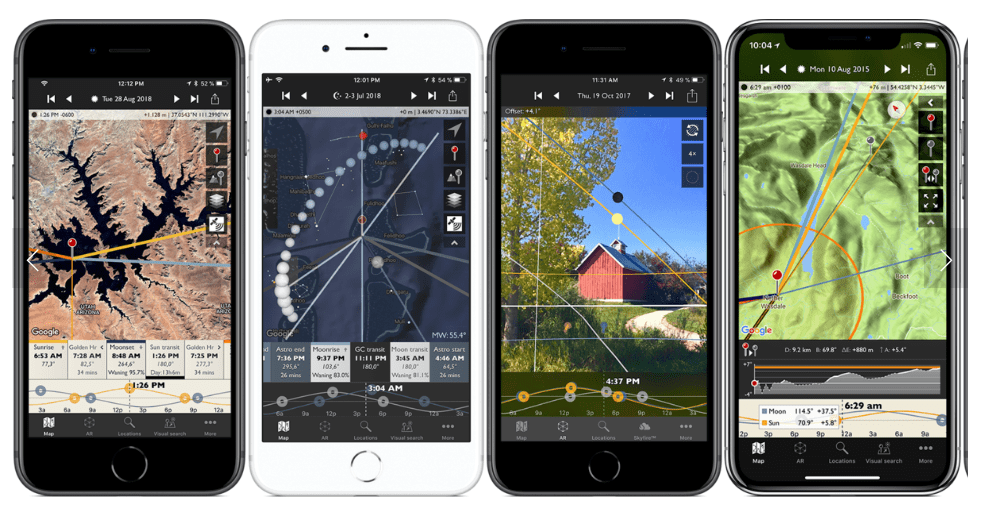
This is a vital factor when photographing the night sky. The timing of the sunset and sunrise may be obvious, but where the moon will be and its brightness can affect your ability to capture the stars. As photographer Marcus Cote says:
“The optimal time to see and photograph the Milky Way is during a new moon or moon phase that is not in the sky at night/early morning.”
This app features 3D augmented reality so that you can visualize your shots and plan how to align them.
This includes the positioning of the Milky Way, pole stars, and major constellations directly over the map.
Photographer’s Ephemeris costs $8.99 but there is also a free desktop version. A similar app worth mentioning is Star Walk.
In January 2021, the makers of this software removed it from the Google Play Store as it needed updating to bring it in line with the iOS version. It should come back for Android users in the near future.
2. Light pollution apps
Light Pollution Map – best light pollution app
A key thing to do then when planning your astrophotography is to check the light pollution for where you are (or where you are going to be).
Light Pollution Map is a simple app that lets you see the light pollution levels in any location.
For example, this shot below shows that if you are in Portland or Seattle, you will have to travel out of those cities to be able to get dark skies:
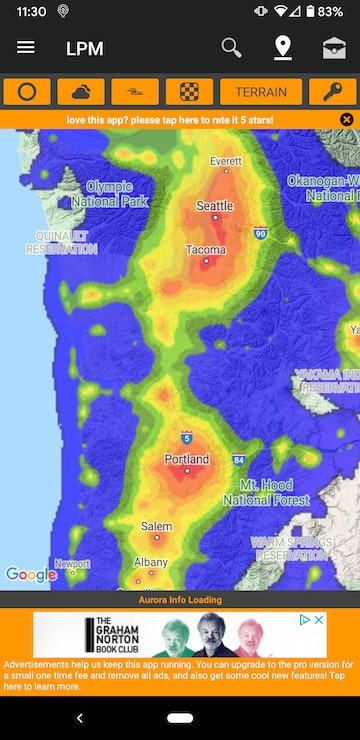
You can zoom in and out and move to investigate any location.
This is from the free version (that includes ads). There is a paid update version available that has additional functionality.
3. Best outdoor conditions and weather forecast apps
Dark Sky – best quick weather checker
Another important thing to consider for taking a picture of stars is the weather conditions when you are planning to shoot the night sky.
You will need skies free of clouds to be able to capture the stars and so having a reliable source of hyperlocal information for this can be essential.
Dark Sky used to be my favorite at-a-glance tool for checking the weather conditions for any upcoming evening, but then it became iPhone-only in August 2020 and so I could no longer use it on my Android phone. Alas, poor me, however, if you are an iPhone user then this is a great astronomy app.
The Dark Sky app is great for its ease of use and nice design that enables you to see when the skies will be clear.
Confusingly, the name is similar to the ‘Dark Sky Finder’ app profiled above but is different with that app being focused on light pollution.
Clear Outside – best detailed weather app
If you are an Android user or would just like more detailed cloud and weather forecasts, then the Clear Outside app from astronomy retailers First Light Optics is a great option.
In the screenshot below you can see that on the night of 9 June 2021 in Boulder, Colorado there are perfect conditions for astrophotography:
- There are no clouds
- There is no chance of rain
- The temperature will drop to the mid-to-low 20’s (Celcius)
- It also shows that the moon is at 0% that day
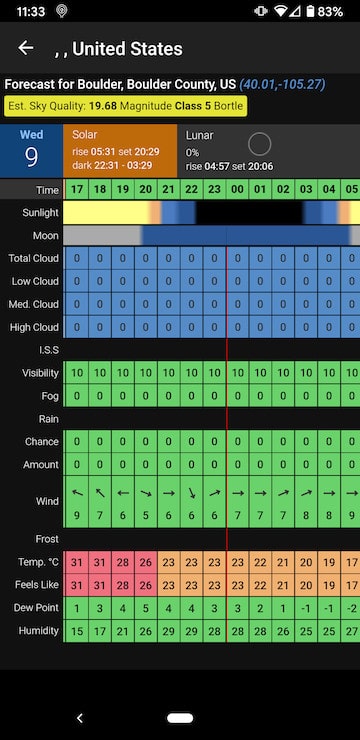
As a planning tool, this is fantastic.
Therefore, this is a really great app for predicting the conditions it’s just a bit harder to read at first compared to the Dark Sky app.
Nightshift
Nightshift provides a great at-a-glance view as to what your stargazing conditions will be tonight, or on any night in the future for your location.
See for example below, I found that on 7 June 2021 astronomy conditions in my location would be poor:
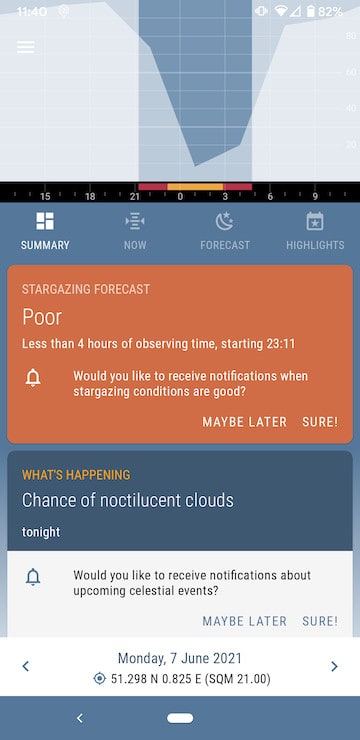
However, if I look ahead a few days then I can see that much better weather conditions are coming in a few days. This is extremely useful in ensuring you don’t waste your time heading out after dark when there is no chance of good astrophotography conditions.
It’s an app for android only for now.
4. Best astrophotography apps that operate your smartphone camera
NightCap Camera – best astrophotography app for iPhone
There are a few great apps that give you greater control of your smartphone’s camera – a bit like using manual mode on a DSLR camera, or an intervalometer.
This can be essential for astronomy photography as you generally need to use long exposures for capturing the faint light from far away objects in the night sky like stars. and/or taking multiple images of the same object in order to stack them.
Night Cap is a specialist low-light photography app that has four astrophotography modes for capturing different things:
- Stars
- Star trails
- Meteor showers
- The International Space Station (ISS)
Unfortunately, it is iPhone only – see below for some great Android alternatives.
ProCam X – best astrophotography app for Android
Another good manual-mode-style camera app is ProCam X.
It enables you to have greater control over your smartphone camera by being able to control things like shutter speed, IOS, white balance, etc.
It does have limitations compared to a DSLR camera – for instance, the max shutter speed it would allow for me would be 3.9 seconds.
This is android only and it’s a paid app, but there is a free lite version if you want to try it out first.
AstroCam
AstroCam is an astrophotography app that allows you greater manual control of your smartphone’s camera settings.
You can program it to take multiple shots at set intervals that you can then stack afterward to get better pictures of the stars and even deep-sky objects.
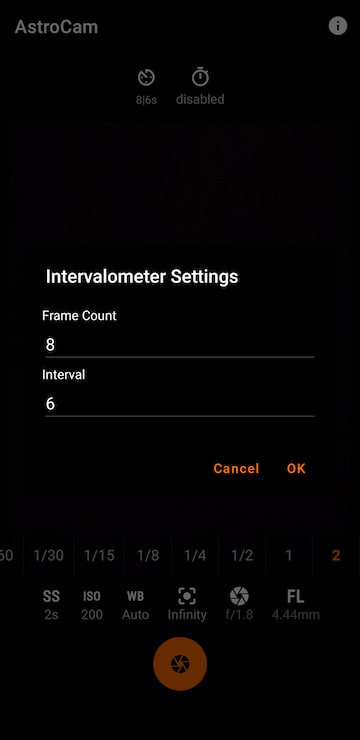
The shutter speed is limited by your camera’s functionality and so may be limited (with my Google Pixel phone it has a maximum of 2 seconds).
DeepSkyCamera
This is another intervalometer app that is intended to enable you to take photos of deep-sky objects with your phone by taking multiple images and stacking them.
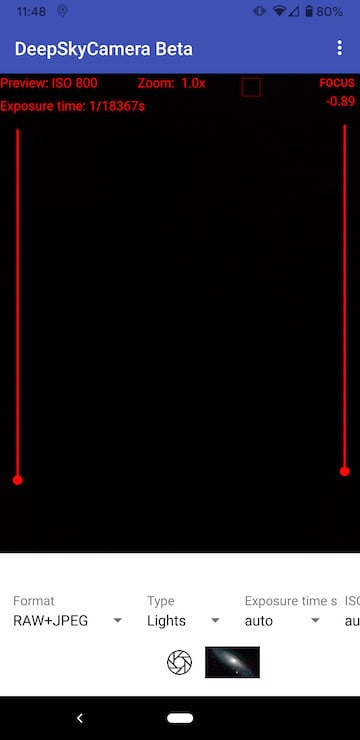
To do this properly, you will need to use a star tracker or telescope mount to account for the rotation of the Earth.
You will also need a smartphone capable of taking photos in RAW format. The app’s website has a helpful table of compatible phones.
The app is still in beta mode and is for Android phones only.
5. ISS and satellite tracking apps
ISS Detector
If you want to try and photo the International Space Station (ISS), then this a helpful tool.
It can save your location and notify you when it will next be visible to you.
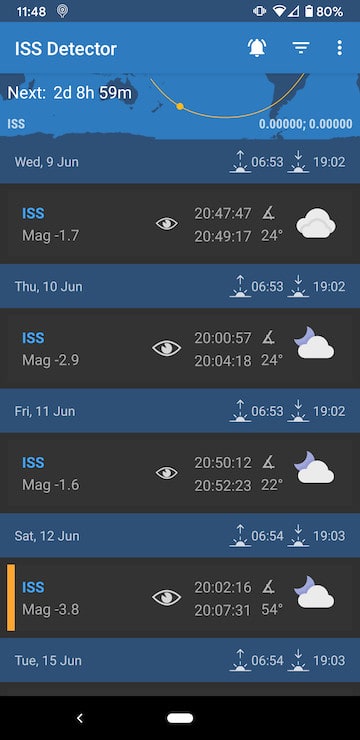
It also tells you where the ISS is at any time and you can also see the live video feed from the station.
Heavens Above
This app will tell you what satellites and other objects will be passing over your head on any night.
It covers more than the ISS detector app above, including all the satellites and objects that you would potentially be able to spot (and photograph).
You can see that tonight there will be multiple STARLINK satellites potentially visible from 21:07 onwards:
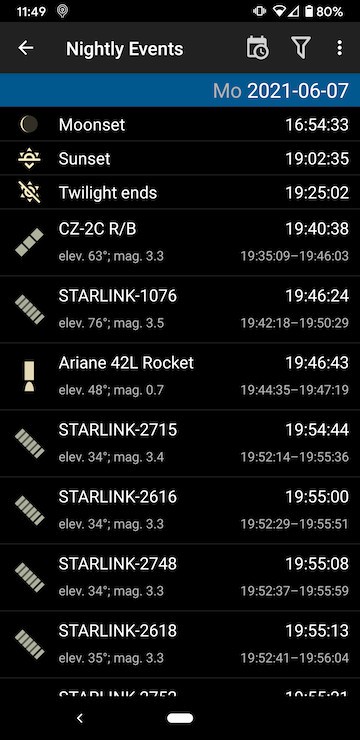
This app is Android only.
6. Other useful apps
Star Trails
This is a processing app that takes multiple exposures of the night sky from your smartphone and processes them to create an image of star trails.
It does not operate your camera, so you have to use either one of the apps above or your phone’s native camera app to capture the images.
Just a Compass
Unless you are a sailor from the 19th century you will sometimes likely need some help working out which way North, South, East, or West is.
This is not strictly an astronomy app but is a basic compass that you can use to help you know which direction you are facing.
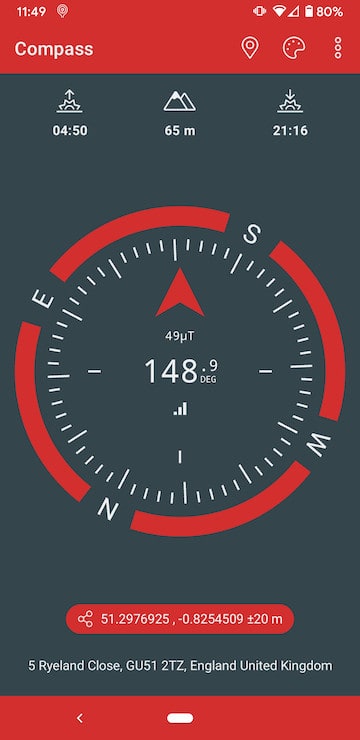
This can aid you to find North-West, for instance, when you know that is where you plan to photograph the stars.
This one is my favorite as it’s simple and easy to use with no frills (and it’s Android only), but there are plenty of good alternatives available.
DarkLight
The DarkLight app converts your phone’s screen to red light so that you can use it as a source of light in the dark without ruining your night vision.
This is pretty handy, especially if you are stargazing with others and want to be considerate of their eyes too!
Over to you – what are the best astrophotography apps?
Using the tools above to help you plan your shots can make things massively easier for yourself and your night sky photography. We hope this has helped you find something useful for you.
If you have any comments or suggestions on different apps and resources, then please let us know in the comments section below.
Many of the astronomy apps and websites above have been recommended by expert astrophotographers that we have interviewed.
If you are new to astrophotography then you might also like our ultimate beginners’ guide, our guide to iPhone astrophotography, and the best phones for astrophotography.
There are also some great telescopes with cameras built-in that you operate by smartphone, check them out here – The Best Telescopes That Take Pictures (Stellina vs Evscope).
Related articles:



Huge thanks mate! I have Astrophotography as a hobby of mine, even because i have a fascination for the beauty of the universe. Anyways, i aprecciate your list and your effort on helping us. I, personally, shot my photos on mobile, with a Xiaomi MI9T Pro, pretty good device, can’t lie.
Huge thanks for the apps! Now i will know the best days to go out with my father and my phone. xD
Another huge thanks, and a hug from a brazilian astrophotographer.
Thanks Júlio! All the best to you and your family.
If you are in North America (Canada, Mexico, US, and the Bahamas) and on your computer, Clear Sky Chart gives you a 3 day forecast specifically aimed at night sky viewing. It has 6316 locations throughout North America. It covers clouds, transparency, seeing, and darkness for the sky and smoke, wind, humidity, and temperature on the ground for each location. It does give the option of the ECWMF model for forecasting the clouds. This forecast model was developed by Allan Rahill of the Canadian Meteorological Center. www.cleardarksky.com
A weather app that is my first go to for forecasting is windy.com. It is best to use on your computer. It has a lot of depth, but it does take some time to learn. A big use for me is helping to predict good color for sunrises and sunsets and storm locations. It gives you a good feel for cloud type. www.windy.com
An android phone app I find useful is “GPS Essentials”, available on the Google Playstore. It has many options, but the ones I use the most are the Dashboard, Compass, and Tracks. The Dashboard is configurable to your pleasure. The Compass speaks for itself. It does both magnetic and true north. The Tracks function is great if you are hiking to a spot for landscape astrophotography. You’re going out in the light and coming back in the dark, which can be a challenge at times. Tracks allows you to plot your way out so you can match it on the return. Little chance for getting lost in unfamiliar territory.
Both cleardarksky.com and windy.com also work on your phone. They are just best when accessed ahead of time on your computer.
My current favorite Smartphone astrophotography weather app. that I find to be the most reliable, most detailed weather forecast on the market and free is “Astrospheric”. It also has a website that you can use as well if your using a laptop or PC.
Google play link:
https://play.google.com/store/apps/details?id=com.astrospheric.dfior.astrospheric
Thanks Drew!
I am loving Astropheric. Thanks for the tip
I’d like to recommend SkySafari 6 pro, the perfect app for anyone seriously interested in astronomy. It has a price and is 2.2gb large, but can show you all the stars and galaxies that have been discovered and gives detailed info on everything. It can give you the exact position of each sky object during any time. Even 50 years into the future or at the time of your birth. It can even be linked to your telescope. Before using, I usually update the minor body database (a simple setting in the app itself) and it can show you the location of all the satellites, in real-time. Also the infamous SpaceX ‘trains’, for instance.
I’m not affiliated with this app, just a fan 🙂
SkySafari app:
https://apps.apple.com/nl/app/skysafari-6-pro/id1306165506?l=en
Stellarium is $13.99 now with no free version. Do you feel it is worth that price?